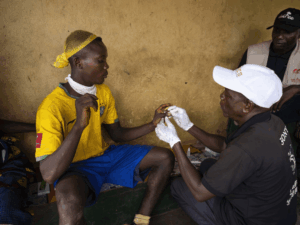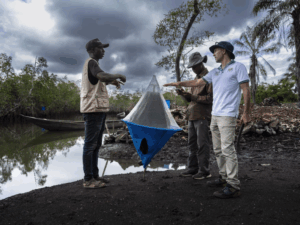Building trust
A story by the Drugs for Neglected Diseases initiative (DNDi)
Photos by Brent Stirton/Getty Images for DNDi
(Read the Introduction to this series here,
Read Step 1, Controlling the TseTse Fly here.)

Back in Dubreka hospital, Macire’s familiarity with the disease is testament to the success the Guinean Sleeping Sickness Programme has had in raising awareness of sleeping sickness. That she willingly comes to the hospital is a clear sign of the trust it has built with local communities.
Since so much of the sleeping sickness work is built around research – from tsetse fly surveys to advanced treatment trials – ensuring the communities understand and appreciate the science has been a major focus.
Researchers found out the importance of this approach the hard way.
In 2014, Guinea – along with Liberia and Sierra Leone – was witness to the largest-ever outbreak of Ebola. After two years of this terrifying disease and over 11,000 deaths, the sleeping sickness elimination programme in Guinea was in tatters. About 10% of all villages in Guinea were affected by Ebola.
The outbreak created a massive loss of trust in the health system, often accusing the system of taking their children, their parents, their friends – never to be seen again.
‘We learned many lessons from Ebola because there was a breakdown in trust between the community and health workers,’ said Prof. Camara. Medical workers were sometimes attacked and gravely injured, including members of Prof. Camara’s team like Mamadou Léno (see video interview above).
Prof Camara’s team would have to build this trust again in the ashes of Ebola.

One approach has been to work with community radio stations, like the Rural Radio of Forécariah, with which the Programme has worked extensively to broadcast sensitization and awareness messages. The station was started during the Ebola outbreak in 2015. ‘Ebola was striking us at our hearts,’ said Mamadou Cissé, the head of the station. ‘We needed a trustworthy channel to communicate to rural populations.’
The Programme now sends representatives to the Rural Radio to announce that they are coming to a given area to test for sleeping sickness. They run interactive programmes to educate people and explain the intentions of the team – for example, why they are taking blood and what they will do with the samples they collect.

Coming soon! Step 3: Going from door to door
Related Articles

Bölët Mouna: Inside Guinea’s Quest to Eliminate Sleeping Sickness (Step 4)
Guinea has achieved a historic milestone by eliminating sleeping sickness as a public health problem, becoming the first country to conquer this deadly neglected tropical disease with the support of DNDi. In Step 4, read about going the last mile.

Bölët Mouna: Inside Guinea’s Quest to Eliminate Sleeping Sickness (Step 3)
Guinea has achieved a historic milestone by eliminating sleeping sickness as a public health problem, becoming the first country to conquer this deadly neglected tropical disease with the support of DNDi. In Step 3, read how going door to door helped the process.

Bölët Mouna: Inside Guinea’s Quest to Eliminate Sleeping Sickness (Step 1)
Guinea has achieved a historic milestone by eliminating sleeping sickness as a public health problem, becoming the first country to conquer this deadly neglected tropical disease with the support of DNDi. In Step 1, read how the tsetse fly was controlled.
